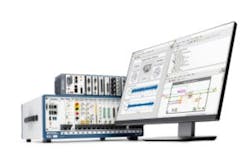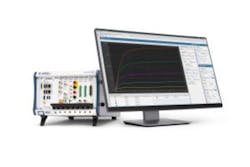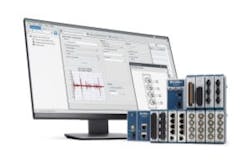LabVIEW, InstrumentStudio, SystemLink, FlexLogger take center stage
Austin, TX. In a software-centric day at NIWeek, National Instruments announced the release of LabVIEW 2018. With the new release, the company said, engineers can increase their speed of innovation by taking advantage of new tools that simplify system integration and grant more control through hardware accessibility. NI also announced the release of InstrumentStudio software for NI PXI modular instruments, SystemLink application software for distributed systems management, and FlexLogger configuration-based data-logging software for validation test.
Applications that impact our daily lives are increasing in complexity due to the rapid innovation brought on by industry trends such as 5G, the Industrial Internet of Things, and autonomous vehicles, NI reported. Consequently, the challenge of testing these devices to ensure reliability, quality, and safety introduces new demands and test configurations, with decreased time and budget. Engineers need better tools to organize, develop and integrate systems so they can accomplish their goals within the acceptable boundaries.
Engineers can use LabVIEW 2018 to address a multitude of these challenges. They can integrate more third-party IP from tools like Python to make the most of the strengths of each package or existing IP from their stakeholders. Test engineers can use new functionality in LabVIEW 2018 to strengthen code reliability by automating the building and execution of software through integration with open interface tools like Jenkins for continuous delivery. Capabilities like this empower test engineers to focus on system integration and development where they can offer unique differentiation, rather than get bogged down in the semantics of how to use software tools or move IP from one to another. For test engineers using FPGAs for high-performance processing, new deep-learning functions and improved floating-point operations can reduce time to market.
“NI’s continued commitment to its software-centric platform accelerates my productivity so I can focus on the challenges that yield the highest ROIs,” said Chris Cilino, LabVIEW framework architect at Cirrus Logic, in a press release. “LabVIEW continues to minimize the effort of adding tests and code modifications to our validation framework, delivering a consistent process to maintain our software and incorporate the reuse of valuable IP without rewrites.”
To meet demands like testing higher complexity DUTs and shorter timeframes, engineers need tools tailored to their needs that they can efficiently use through their workflow, helping them to meet their exact application requirements. LabVIEW 2018 is the latest addition to NI’s software-centric platform that features products tailored to needs within distinct stages of their workflow—products that have been adopted in whole or in part by more than 300,000 active users.
With InstrumentStudio software providing an interactive multi-instrument experience, TestStand test management software handling overall execution and reporting, and SystemLink software managing assets and software deployments, this workflow improves the productivity of test and validation labs across many industries. Each piece of the workflow is also interoperable with third-party software to maximize code and IP reuse and draws on the LabVIEW Tools Network ecosystem of add-ons and tools for more application-specific requirements.
Engineers can access both LabVIEW 2018 and LabVIEW NXG (the latest version of which was introduce in January) with a single purchase of LabVIEW. For more information, visit ni.com/labview.
InstrumentStudio
NI said InstrumentStudio improves the live, interactive use model for modular instruments and makes debugging while running tests more intuitive. Engineers in the aerospace, automotive, and semiconductor industries benefit from a more effective workflow for test-system development.
InstrumentStudio evolves the concept of single-instrument soft front panels into a unified, multi-instrument environment, so engineers can capture screenshots and measurement results in one view from their suite of instruments. InstrumentStudio can also save project-level configurations for specific devices under test that can be repurposed later or shared with colleagues. This efficiency is key for testing high-mix devices and provides test repeatability at a convenience to the engineer or technician.
At different stages in the product design cycle, test engineers often waste valuable time correlating measurements between similar tests that ultimately use different hardware. And in production test, engineers who need to debug on the manufacturing floor may invest in separate hardware either for monitoring their tests or debugging their automated test equipment.
InstrumentStudio addresses these challenges by exporting configuration files to programming environments that reproduce settings, thereby simplifying measurement correlation. In addition, test engineers can monitor PXI instrument behavior by running InstrumentStudio while test sequences execute in parallel, streamlining the debug process. Through these seamless interactions with programming environments and test sequences, InstrumentStudio becomes part of a comprehensive software workflow and helps engineers maximize their investment in PXI instrumentation.
“For two decades, test and validation engineers have reduced their total cost of test and brought products to market faster using modular instruments on the PXI platform,” said Luke Schreier, vice president of product marketing at NI. “InstrumentStudio makes using NI PXI instruments even easier—from initial product discovery to system debugging—all with intuitive connections to programming environments and test sequencers. It’s a valuable tool in unlocking the full potential and usability of your bench or automated test rack.”
InstrumentStudio is included with the purchase of an NI PXI instrument. Engineers can also download the complimentary software from ni.com for use with existing NI products. For more information, visit ni.com/instrumentstudio.
SystemLink
NI said SystemLink helps improve operational efficiency and decrease maintenance costs through a centralized interface for automating tasks such as software deployment, remote device configuration, and system health performance monitoring.
The company reported that emerging trends coupled with existing realities like maintaining distributed legacy systems are inspiring companies to seek new approaches to systems management. Consequently, companies must balance their adoption of new, connected technologies while preserving support for valuable legacy assets with long life cycles.
Systems that manage, maintain and extract insight from small-scale pilots or groups of systems are relatively straightforward to implement. However, attention now shifts toward the next challenge, which is scaling and managing large deployments, varying lifecycle stages, and distributed testers and nodes across entire plants, fabs and factories. This challenge includes tasks like remote software and system configuration as well as data management and performance monitoring, and applies to industries such as aerospace and defense, transportation and manufacturing.
SystemLink enables engineers to connect, deploy, and manage distributed systems, both NI and third-party, through a centralized interface accessible from anywhere, making it possible for them to remotely configure and deploy software, monitor the health and performance of their equipment, manage alarms, and visualize application parameters. In addition, engineers can automate the communication of data to customer-defined dashboards and remote operator interfaces.
“SystemLink substantially reduces the administration time necessary to deploy software and manage configurations on test systems,” said Daniel Huang, head of testing technology at Siemens AG, in a press release. “This enables our engineering teams to focus on higher-value tasks.” For more information, visit ni.com/systemlink.
FlexLogger
NI said that FlexLogger configuration-based data-logging software for validation test offers intuitive workflows and integrated data management. FlexLogger helps automotive test departments quickly capture accurate, well-documented data to verify system functionality in real-world conditions and comply with strict government regulations.
Technology innovations in areas like active safety, electrification and vehicle-to-everything (V2X) communication are disrupting how the automotive industry designs, tests, and produces vehicles. Rapidly evolving components and systems including sensor fusion, high-capacity batteries, and deep learning demand a higher volume of testing with accurate, traceable results to exceed safety-critical expectations for quality and reliability. These trends are pulling automotive test departments in different directions, intensifying challenges to build increasingly complex, mixed-measurement test systems under compressed timelines, while managing the explosive growth of collected data.
Engineers can use FlexLogger to help simplify test configurations and extract key insights with sensor-specific workflows to acquire and log synchronized, mixed measurements. They can integrate analog sensors, digital pulse frequencies, CAN signals, and calculated channels that are all logged to the universal Technical Data Management Streaming (TDMS) file format, so data can be correlated and analyzed to accurately characterize an entire system. These capabilities also address similar challenges faced by test departments in other industries including heavy equipment, aerospace, appliances and academic research.
For example, heavy equipment manufacturers like CNH Industrial design and produce variations of powertrain systems for different vehicles like agricultural machines, construction equipment, trucks and buses. Each system has unique specifications for functionality and performance, which means every test has different requirements to integrate new sensors and industrial protocols.
“Characterizing a combine harvester drivetrain requires a mix of different measurements including pressure, temperature, current, CAN and shaft speed,” said Andy Tarman, lab test engineer at CNH Industrial, in a press release. “FlexLogger makes it easier to troubleshoot and verify that the raw data from different sensors are correct before I start my test. This helps shorten test development by saving time typically wasted on redoing configurations.”
These configuration-based workflows are the cornerstone that now empowers technicians to streamline test development, integrate new measurements and manage data using NI’s flexible software platform and modular hardware. For example, leveraging NI’s data management expertise, FlexLogger automatically logs descriptive metadata about the test configuration including sensor and hardware acquisition settings for easier traceability. Test departments can improve access to data and effectively communicate results to the organization using DIAdem data management software to find, analyze and report on FlexLogger data. For more information, visit ni.com/flexlogger.





